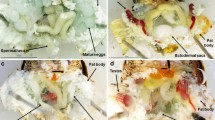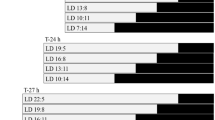Summary
The time measuring system ofDrosophila littoralis strains originating between 40–70° N was found to be highly variable and latitude dependent. The critical daylength for photoperiodic adult diapause varied from 12 h or no diapause response in the south to 20 h in north. The median timing of pupal eclosion rhythm varied correspondingly from 21 h to 12 h from lights off in LD 3∶21, and the period of free-running rhythm of eclosion from 24 h to 19 h. The phase of the free-running rhythm was also variable, and correlated with the phase of the entrained rhythm. Latitudinal variation in the entrained rhythm of eclosion and in diapause is adaptive, leading to eclosion early in the morning and to overwintering at the adult stage. In some strains with a late phase of eclosion, strong transient cycles were seen following the transition from LL to DD. A total damping of the free-running eclosion rhythm within 2–7 days was common to all strains. This damping was more pronounced in the northern strains. The phase and period of eclosion rhythms were statistically independent. Diapause was not correlated with any parameters of the eclosion rhythm in the analysis. Diapause may still be influenced by the period of the eclosion rhythm, even though its minor contribution may be masked by a more variable, eclosion rhythm independent system in the determination of diapause.
Similar content being viewed by others

Abbreviations
- LD :
-
Light/dark; as in LD 3∶21 meaning a cycle of 3 h light∶21 h darkness
- LL :
-
Continuous light
- DD :
-
Continuous darkness
- T :
-
Period of a Zeitgeber cycle
- τ :
-
Natural period of eclosion rhythm in constant conditions
- ψ EL :
-
Phase of the free-running rhythm of eclosion
- A :
-
Amplitude of the free-running rhythm of eclosion; possible range is from 4.17% (no rhythmicity) to 20% (the daily eclosion peaks 2–6 within 5 h each)
- P :
-
Persistence of the free-running rhythm of eclosion; the number of daily eclosion peaks where the mean for five highest hourly percentages still exceed 6%
- Δφ :
-
A phase shift, expressed in h; a re-setting of a rhythm; either as an advance shift (i.e. earlier= +Δφ), or as a delay shift (i.e. later = −Δφ)
- PRC :
-
Phase-response curve
- ψ LD :
-
Phase of entrained rhythm of eclosion; e.g.ψ LD 3∶21 is the median hour of eclosion peak from ‘lights off’ at LD 3∶21
- SD ecl :
-
Amplitude of the entrained rhythm of eclosion; the smaller SDecl the higher the amplitude
- PPRC :
-
Photoperiodic response curve; proportion of females in diapause displayed as a function of daylength
- CDL :
-
Critical photoperiod; the photoperiod in the 24 h LD cycle at which 50% of the population studied diapauses
- SD diap :
-
Accuracy of diapause response of a strain; the smaller the SDdiap the more accurate the response
- Cdl :
-
The main locus controlling CDL inD. littoralis
References
Allemand R, David JR (1976) The circadian rhythm of oviposition inDrosophila melanogaster: A genetic latitudinal cline in wild populations. Experientia 32:1403–1404
Allemand R, David JR (1984) Genetic analysis of the circadian oviposition rhythm inDrosophila melanogaster: Effects of drift in laboratory strains. Behavior Genetics 14:31–43
Bargiello TA, Young MW (1984) Molecular genetics of a biological clock inDrosophila. Proc Natl Acad Sci USA 81:2142–2146
Beck SD (1968) Insect photoperiodism. Academic Press, New York London
Bollig I (1977) Different circadian rhythms regulate photoperiodic flowering response and leaf movement inPharbitis nil (L.) choisy. Planta 135:137–142
Brady J (1981) Behavioral rhythms in invertebrates. In: Aschoff J (ed) Biological rhythms. (Handbook of behavioral neurobiology, vol. 4) Plenum, New York, pp 125–144
Bünning E (1935) Zur Kenntnis der endonomen Tagesrhythmik bei Insekten und bei Pflanzen. Ber Dtsch Bot Ges 53:594–623
Bünning E (1936) Die endonome Tagesrhythmik als Grundlage der photoperiodischen Reaktion. Ber Dtsch Bot Ges 54:590–607
Chandrashekaran MK, Loher W (1969) The effect of light intensity on the circadian rhythms of eclosion inDrosophila pseudoobscura. Z Vergl Physiol 62:337–347
Clayton DL, Paietta JV (1972) Selection for circadian eclosion time inDrosophila melanogaster. Science 178:994–995
Danilevskii AS (1965) Photoperiodism and seasonal development of insects. Oliver & Boyd, London
Danilevskii AS, Goryshin NI, Tyschenko VP (1970) Biological rhythms in arthropods. Annu Rev Entomol 15:201–244
Engelmann W, Mack J (1978) Different oscillators control the circadian rhythm of eclosion and activity inDrosophila. J Comp Physiol 127:229–237
Enomoto O (1981) Larval diapause inChymomyza costata (Diptera: Drosophilidae). I. Effects of temperature and photoperiod on the development. Low Temp Sci, Ser B 39:21–29
Enright JT (1965) The search of rhythmicity in biological time-series. J Theor Biol 8:426–468
Folkard S, Wever RA, Wildgruber CM (1983) Multi-oscillatory control of circadian rhythms in human performance. Nature 305:223–226
Geyspits KF, Simonenko NP (1970) An experimental analysis of seasonal changes in the photoperiodic reaction ofDrosophila phalerata Meig. (Diptera, Drosophilidae). Entomol Rev Wash 49:46–54
Handler AM, Konopka RJ (1979) Transplantation of a circadian pacemaker inDrosophila. Nature 279:236–238
Jackson FR (1983) The isolation of biological rhythm mutations in the autosomes ofDrosophila melanogaster. J Neurogenet 1:3–15
Kimura MT (1982) Effects of photoperiod and temperature on reproductive diapause inDrosophila testacea. Experientia 38:371–372
Kimura MT (1984) Geographic variation of reproductive diapause in theDrosophila auraria complex (Diptera: Drosophilidae). Physiol Entomol 9:425–431
Konopka RJ, Benzer S (1971) Clock mutants ofDrosophila melanogaster. Proc Natl Acad Sci USA 68:2112–2116
Lakovaara S (1969) Malt as a culture medium forDrosophila species. Dros Inf Serv 44:128
Lankinen P (1979) The latitudinal cline in the diel and circadian rhythm of the pupal eclosion inDrosophila littoralis. Proc 10th meeting of the Scandinavian Association of Geneticists. Umeå, Sweden
Lankinen P (1981) The parallel latitudinal clines of pupal emergence rhythm and adult photoperiodic diapause inDrosophila littoralis. Abstr 7th European Dros Res Conf, p 69, Oulu, Finland
Lankinen P (1982) The inheritance of the pupal eclosion rhythm inDrosophila littoralis. Hereditas 97:324–325
Lankinen P (1986) Genetic correlation between circadian eclosion rhythm and photoperiodic diapause inDrosophila littoralis. J Biol Rhythms 1 (in press)
Lankinen P, Lumme J (1982) An improved apparatus for recording the eclosion rhythm inDrosophila. Dros Inf Serv 58:161,163
Lankinen P, Lumme J (1984) Genetic analysis of geographical variation in photoperiodic diapause and pupal eclosion rhythm inDrosophila littoralis. In: Photoperiodic regulation of insect and molluscan hormones. (Ciba Foundation Symposium 104) Pitman, London, pp 97–114
Lumme J (1978) Phenology and photoperiodic diapause in northern populations of Drosophila. In: Dingle H (ed) Evolution of insect migration and diapause. Springer, Berlin Heidelberg New York, pp 145–170
Lumme J (1981) Localization of the genetic unit controlling the photoperiodic adult diapause inDrosophila littoralis. Hereditas 94:241–244
Lumme J, Keränen L (1978) Photoperiodic diapause inDrosophila lummei Hackman is controlled by an X-chromosomal factor. Hereditas 89:261–262
Lumme J, Lakovaara S (1984) Seasonality and diapause in drosophilids. In: Ashburner M, Carson HL, Thompson JJ Jr (eds) The genetics and biology ofDrosophila, vol 3. Academic Press, London, pp 171–220
Lumme J, Oikarinen A (1977) The genetic basis of the geographically variable photoperiodic diapause inDrosophila littoralis. Hereditas 86:129–142
Lumme J, Pohjola L (1980) Selection against photoperiodic diapause started from monohybrid crosses inDrosophila littoralis. Hereditas 92:337–378
Lumme J, Muona O, Orell M (1978) Phenology of boreal drosophilids (Diptera). Ann Ent Fenn 44:73–85
Masaki S (1984) Unity and diversity in insect photoperiodism. In: Photoperiodic regulation of insect and molluscan hormones. (Ciba Foundation Symposium 104) Pitman, London, pp 7–25
Mayer W (1966) Besonderheiten der circadianen Rhythmik bei Pflanzen verschiedener geographischer Breiten. Planta 70:237–256
Minami N, Kimura MT, Ichijo N (1979) Physiology of reproductive diapause inDrosophila auraria: Photoperiod and temperature as controlling factors. Kontyû, Tokio 47:244–248
Muona O, Lumme J (1981) Geographical variation in the reproductive cycle and photoperiodic diapause ofDrosophila phalerata andD. transversa (Drosophilidae: Diptera). Evolution 35:158–167
Pflüger W (1973) Die Sanduhrsteuerung der gezeitensynchronen Schlüpfrhythmik der MückeClunio marinus im arktischen Mittsommer. Oecologia 11:113–150
Pflüger W, Neumann D (1971) Die Steuerung einer gezeitenparallelen Schlüpfrhythmik nach dem Sanduhr-Prinzip. Oecologia 7:262–266
Pittendrigh CS (1954) On temperature independence in the clock system controlling emergence time inDrosophila. Proc Natl Acad Sci USA 40:1018–1029
Pittendrigh CS (1960) Circadian rhythms and the circadian organization of living systems. In: Cold Spring Harbor Symp Quant Biol 25:159–194
Pittendrigh CS (1965) On the mechanism of the entrainment of a circadian rhythm by light pulses. In: Circadian Clocks. J Aschoff (ed) North-Holland Pub Comp, Amsterdam, pp 277–297
Pittendrigh CS (1966) The circadian oscillation inDrosophila pseudoobscura pupae: A model for the photoperiodic clock. Z Pflanzenphysiol 54:275–307
Pittendrigh CS (1967) Circadian systems, I. The driving oscillation and its assay inDrosophila pseudoobscura. Proc Natl Acad Sci USA 58:1762–1767
Pittendrigh CS (1972) Circadian surfaces and the diversity of possible roles of circadian organization in photoperiodic induction. Proc Natl Acad Sci USA 69:2734–2737
Pittendrigh CS (1974) Circadian oscillation in cells and the circadian organization of multicellular systems. In: Schmitt FO, Worden FG (eds) The neurosciences third study program. MIT Press, Cambridge, pp 437–458
Pittendrigh CS (1981a) Circadian organization and the photoperiodic phenomena. In: Follett BK, Follett DE (eds) Biological clocks in seasonal reproductive cycles. Wright, Bristol, pp 1–35
Pittendrigh CS (1981b) Circadian systems: entrainment. In: Aschoff J (ed) Biological rhythms. (Handbook of behavioral neurobiology, vol 4). Plenum, New York, pp 95–124
Pittendrigh CS (1984) In ‘Discussion’ after Lankinen and Lumme 1984. Genetic analysis of geographical variation in photoperiodic diapause and pupal eclosion rhythm inDrosophila littoralis. In: Photoperiodic regulation of insect and molluscan hormones. (Ciba Foundation symposium 104) Pitman, London, pp 97–114
Pittendrigh CS, Minis DH (1964) The entrainment of circadian oscillations by light and their role as photoperiodic clocks. Am Nat 98:261–294
Pittendrigh CS, Minis DH (1971) The photoperiodic measurement inPectinophora gossypiella and its relation to the circadian system in that species. In: Menaker M (ed) Biochronometry. National Academy of Sciences, Washington DC, pp 212–250
Pittendrigh CS, Bruce V, Kaus P (1958) On the significance of transients in daily rhythms. Proc Natl Acad Sci USA 44:965–973
Pittendrigh CS, Elliot J, Takamura T (1984) The circadian component in photoperiodic induction. In: Photoperiodic induction of insect and molluscan hormones. (Ciba Foundation symposium 104) Pitman, London, pp 26–47
Riihimaa A (1984) The inheritance of the facultative diapause ofChymomyza costata. Hereditas 101:283
Reddy P, Zehring WA, Wheeler DA, Pirrotta W, Hadfield C, Hall JC, Rosbash M (1984) Molecular analysis of theperiod locus inDrosophila melanogaster and identification of a transcript involved in biological rhythms. Cell 38:701–710
Rusak B (1981) Vertebrate behavioral rhythms. In: J Aschoff (ed) Biological rhythms (Handbook of behavioral neurobiology, vol 4) Plenum, New York, pp 183–213
Sargent ML, Briggs WR (1967) The effects of light on a circadian rhythm of conidiation inNeurospora. Plant Physiol 42:1504–1510
Saunders DS (1976) Insect clocks. Pergamon Press, Oxford
Saunders DS (1978) An experimental and theoretical analysis of photoperiodic induction in the flesh-fly,Sarcophaga argyrostoma. J Comp Physiol 124:75–95
Shin H-S, Bargiello TA, Clark BT, Jackson FR, Young MW (1985) An unusual coding sequence from aDrosophila clock gene is conserved in vertebrates. Nature 317:445–448
Sokal RR, Rohlf FJ (1981) Biometry, 2nd edn. Freeman, San Francisco
Throckmorton LH (1982) Thevirilis group. In: Ashburner M, Carson HL, Thompson JJ Jr (eds) The genetics and biology ofDrosophila, vol 3b. Academic Press, London, pp 227–296
Watabe H (1983) Photoperiodic responses in theDrosophila virilis species group (Diptera, Drosophilidae) from Japan. Kontyû, Tokyo 51:628–634
Winfree AT (1970) The temporal morphology of a biological clock. In: Gerstenhaber M (ed) Lectures on mathematics in the life sciences, vol 2. American Mathematical Society, Providence, RI, pp 109–150
Winfree AT (1974) SuppressingDrosophila circadian rhythm with dim light. Science 183:970–972
Winfree AT (1980) The geometry of biological time. Biomathematics 8, Springer, New York
Zimmermann WF (1969) On the absence of circadian rhythmi-city inDrosophila pseudoobscura pupae. Biol Bull 136:494–500
Zimmermann WF, Ives D (1971) Some physiological aspects of circadian rhythmicity inDrosophila. In: Menaker M (ed) Biochronometry. National Academy of Sciences, Washington DC, pp 381–391
Author information
Authors and Affiliations
Rights and permissions
About this article
Cite this article
Lankinen, P. Geographical variation in circadian eclosion rhythm and photoperiodic adult diapause inDrosophila littoralis . J. Comp. Physiol. 159, 123–142 (1986). https://doi.org/10.1007/BF00612503
Accepted:
Issue Date:
DOI: https://doi.org/10.1007/BF00612503



